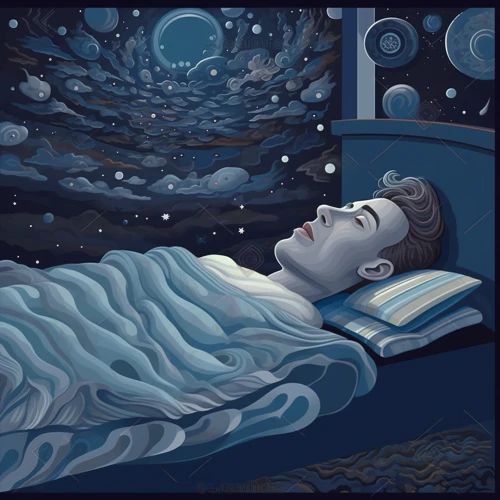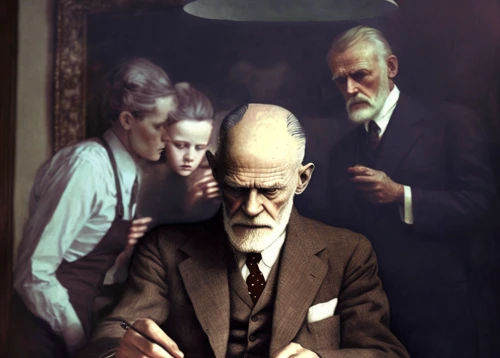Curiosity often leads us down the rabbit hole of our dreams, where the hidden meanings and mysteries of our subconscious mind come to life in vivid and sometimes perplexing ways. Psychoanalysts have long been fascinated by the hidden elements that manifest in our dreams, seeking to decipher the symbolism and uncover the buried desires that lay within. In this article, we will delve into the intriguing world of dream analysis and explore what psychoanalysts call the hidden in dreams. From unconscious desires and repressed memories to the influence of the hidden on dream manifestation, we will unravel the secrets that lie beneath the surface. So, join us on this journey of self-discovery as we uncover the enigmatic realm of dreams and the hidden messages they hold.
The Concept of the Hidden in Dreams

The concept of the hidden in dreams revolves around the idea that our subconscious mind holds a wealth of information, desires, and memories that may not be immediately accessible to our conscious awareness. Psychoanalysts delve into the depths of the hidden, exploring the intricate web of symbolism and manifestations that appear in our dreams. Unconscious desires and symbolism play a significant role in this exploration, as do repressed memories and subconscious manifestations. Through various interpretation techniques, psychoanalysts aim to unlock the hidden meanings behind dream images and uncover the buried desires that shape our subconscious landscape. The hidden serves as a crucial component in dream analysis, offering insights into our innermost thoughts, fears, and desires.
1. Unconscious Desires and Symbolism
In the realm of dream analysis, unconscious desires take center stage, representing the hidden wishes and longings that lie beneath our conscious awareness. These desires often manifest symbolically in our dreams, using imagery and metaphors to convey deeper meanings. Psychoanalysts keenly study these symbols, recognizing that they hold the key to unraveling the hidden messages within dreams. By interpreting these symbols, analysts can uncover the true nature of our desires and shed light on the unconscious motivations that influence our thoughts and actions. Whether it’s a recurring dream theme or a specific symbol that appears, delving into the realm of unconscious desires and symbolism allows psychoanalysts to navigate the intricate labyrinth of our innermost thoughts and emotions.
2. Repressed Memories and Subconscious Manifestations
Repressed memories and subconscious manifestations are key elements within the concept of the hidden in dreams. Our subconscious mind has the ability to bury traumatic experiences and memories that may be too painful for our conscious mind to process. These repressed memories often find their way into our dreams, manifesting in symbolic and metaphorical ways. Psychoanalysts believe that by interpreting these manifestations, they can bring repressed memories to the surface, allowing individuals to confront and heal from past traumas. The hidden nature of these memories adds another layer of complexity to dream analysis, as they may be disguised or symbolically represented in the dream narrative. By unraveling these hidden elements, psychoanalysts can help individuals gain insights into their subconscious mind and promote psychological growth and healing.
3. Interpretation Techniques Used by Psychoanalysts
Psychoanalysts employ various interpretation techniques to decipher the hidden meaning behind the symbols and manifestations in dreams. One commonly used technique is free association, where patients freely express their thoughts and feelings without censorship. This allows unconscious desires and repressed memories to surface. Another technique is dream analysis, where psychoanalysts carefully analyze the symbols, actions, and themes in a dream to reveal underlying messages. They may also use symbolism dictionaries or personal experiences to interpret dream elements. Additionally, therapists may employ projective techniques, such as asking patients to draw or imagine certain dream scenes, to gain further insights into their hidden desires and thoughts. These interpretation techniques provide valuable tools for psychoanalysts to unravel the mysteries of the hidden in dreams.
4. Role of Hidden Desires in Dream Analysis
The role of hidden desires in dream analysis is paramount. Our dreams act as a conduit for these hidden desires to manifest, providing glimpses into our deepest longings and unfulfilled wishes. By examining the symbolism and imagery within dreams, psychoanalysts can uncover the hidden desires that reside within the depths of our unconscious mind. These desires may be masked, distorted, or symbolically represented in our dreams, making the analysis process both complex and fascinating. The hidden desires that emerge in dream analysis allow individuals to gain a better understanding of their innermost needs and motivations, ultimately aiding in personal growth and psychological well-being.
The Influence of the Hidden on Dream Manifestation

The influence of the hidden on dream manifestation is a fascinating aspect of dream analysis. Dreams often present themselves through symbolic representations and metaphors, acting as a bridge between the conscious and unconscious mind. The hidden desires, fears, and traumas that lie beneath the surface can manifest in various ways within our dreams, shaping their content and narrative. Symbolic representations allow the subconscious to communicate its messages in a coded language, requiring interpretation to uncover their true meaning. Additionally, hidden fears and traumas may find expression in dreams, providing opportunities for healing and understanding. The influence of the hidden on dream manifestation is an intricate dance between the conscious and unconscious, unveiling layers of our psyche that may remain concealed in waking life.
Examples:
The Influence of the Hidden on Dream Manifestation:
- Symbolic Representations and Metaphors: Dreaming of flying can represent a desire for freedom or a need to escape from a challenging situation.
- Manifestation of Hidden Fears and Traumas: Nightmares may reflect unresolved traumas or deep-seated fears, allowing the subconscious to confront and process them in a safer environment.
1. Symbolic Representations and Metaphors
Symbolic representations and metaphors are prevalent in dreams, offering glimpses into the hidden aspects of our psyche. In dream analysis, psychoanalysts strive to decode these symbols to gain a deeper understanding of the unconscious desires and concerns that lie beneath the surface. A waterfall may symbolize the release of emotions, while a staircase might represent progress or obstacles in life. These symbols can be personal or universal, with meanings that vary from individual to individual. By unraveling the symbolic language of dreams, psychoanalysts can uncover valuable insights into the inner workings of the mind, shedding light on hidden fears, desires, and unresolved conflicts that impact our waking lives.
2. Manifestation of Hidden Fears and Traumas
The manifestation of hidden fears and traumas in dreams is a significant aspect of dream analysis. Our subconscious mind often uses dreams as a conduit to bring to light the fears and traumas that we may have buried deep within ourselves. These hidden fears and traumas can stem from past experiences, unresolved conflicts, or repressed memories. In dreams, they may appear in various forms such as recurring nightmares, disturbing imagery, or symbolic scenarios. Psychoanalysts carefully examine these dream elements to uncover the underlying fears and traumas that are influencing our subconscious mind. By bringing these hidden fears and traumas to the surface, individuals can work towards understanding, processing, and ultimately healing from their past experiences.
Unveiling the Hidden in Lucid Dreams

Unveiling the hidden in lucid dreams opens up a realm of conscious exploration of the unconscious. Lucid dreaming allows individuals to become aware that they are dreaming and gives them the ability to actively participate and shape the dream narrative. During these extraordinary dream states, communication with the shadow self, or the hidden aspects of our personality, can occur. This self-reflection and interaction provide a unique opportunity to gain insights into our fears, desires, and unresolved issues. Lucid dreaming can be seen as a tool for self-discovery, enabling individuals to confront and address the hidden aspects of their psyche directly. Through conscious exploration in lucid dreams, we can unravel the secrets and mysteries that lie within our hidden selves, fostering personal growth and understanding.
1. Conscious Exploration of the Unconscious
Conscious exploration of the unconscious is a fascinating aspect of dream analysis. In lucid dreams, individuals possess awareness and control while navigating the hidden realms of the mind. This state allows for a unique opportunity to delve deeper into the layers of the subconscious and gain insights into one’s innermost thoughts and desires. Psychoanalytic practitioners encourage techniques such as reality testing and deliberate questioning within lucid dreams to better understand the hidden symbolism and messages that emerge. By consciously exploring the unconscious, individuals can unravel the mysteries within their dreams and gain a deeper understanding of themselves. Lucid dreaming serves as a powerful tool for accessing the hidden aspects of the mind and allows for self-exploration and personal growth.
2. Communication with the Shadow Self
Communication with the shadow self is a fascinating aspect of dream exploration. The shadow self represents the hidden, darker aspects of our personality that we may not readily acknowledge or accept. In dreams, the shadow self can manifest as a separate entity or take on various forms. By interacting with the shadow self in our dreams, we have an opportunity to confront suppressed emotions, unresolved conflicts, and hidden fears. This communication process allows us to gain a deeper understanding of ourselves and work towards integration and balance. It is through this inner dialogue with the shadow self that we can begin to embrace and integrate our hidden aspects, leading to growth and self-discovery.
Common Interpretations of Hidden Dream Elements
Common interpretations of hidden dream elements provide valuable insights into the deeper meanings behind the symbols and experiences we encounter while dreaming. Water symbolism often represents the depths of our emotions and the unconscious mind. Dreams of pursuit reflect our unconscious pursuit of unfulfilled desires and goals. Masks and disguises in dreams can be seen as symbols of concealing our true selves or hiding aspects of our identity. These interpretations offer a glimpse into the hidden layers of our dreams, bringing to light the subconscious themes and messages that may be influencing our thoughts and behaviors in waking life. By unraveling these hidden dream elements, psychoanalysts can help individuals gain a deeper understanding of their innermost selves and work towards personal growth and self-awareness.
1. Water Symbolism: Emotions and the Depths of the Psyche
Water symbolism in dreams holds a fascinating connection to our emotions and the depths of our psyche. Psychoanalysts recognize water as a powerful symbol that represents the ebb and flow of our emotions, as well as the subconscious reservoir of our thoughts and feelings. Dreams featuring oceans, rivers, or even small bodies of water can signify the intensity of our emotions and the vastness of our unconscious mind. The state of the water, whether calm or turbulent, can reflect the emotional state we are currently experiencing. Additionally, the presence of water creatures like fish or whales may further symbolize hidden aspects of our psyche, such as hidden fears or desires swimming beneath the surface. As psychoanalysts unravel the hidden meanings of water symbolism in dreams, they gain insight into the complex and profound nature of our emotional landscape.
2. Pursuit Dreams: Chasing Unfulfilled Desires
In the enigmatic realm of dreams, pursuit dreams hold a special place, symbolizing our relentless pursuit of unfulfilled desires. These dreams often manifest as a chase, whether we are the pursuer or the pursued. Psychoanalysts interpret these dreams as a reflection of our subconscious yearnings and aspirations that have not yet been realized in our waking lives. The hidden message behind pursuit dreams is the longing for something that is just out of reach. It can represent a desire for success, love, or personal fulfillment. As we chase after our dreams in the dream world, our subconscious mind reveals the unmet desires that drive us, urging us to take action and explore what lies beyond the surface of our waking existence.
3. Masks and Disguises: Concealing the True Self
Masks and disguises in dreams offer a fascinating glimpse into the concept of concealing the true self. This dream element often symbolizes the various roles we play in our waking lives, the different personas we adopt to fit societal expectations, or even the attempts to hide our authentic selves from others. The use of masks and disguises in dreams can reflect a sense of insecurity or fear of judgment, where individuals feel the need to hide their true personalities, emotions, or desires. Psychoanalysts examine these dreams to understand the underlying reasons behind this need for concealment and to explore avenues for self-acceptance and expression. Unraveling the symbolism and meaning behind masks and disguises can lead to a deeper understanding of the inner conflicts and struggles individuals may face in their waking lives.
Conclusion
In conclusion, the concept of the hidden in dreams reveals the profound influence of our subconscious mind on the content and symbolism of our dreams. Psychoanalysts explore the hidden to uncover the layers of meaning and symbolism that reside within our dreams. From unconscious desires and repressed memories to the manifestation of fears and traumas, the hidden elements in dreams provide a gateway to understanding our innermost thoughts and emotions. Through techniques such as dream interpretation and analysis, psychoanalysts aim to decode the messages that the hidden elements of our dreams convey. By unraveling the mysteries of the hidden, we can gain insights into our psyche and discover valuable information about ourselves. So, the next time you delve into the world of dreams, remember to pay attention to the hidden, for it holds the key to unlocking the secrets of your subconscious mind.
Frequently Asked Questions
1. What is the significance of unconscious desires in dream analysis?
Unconscious desires hold a significant role in dream analysis as they represent the hidden motivations and wishes that our conscious mind may not be aware of. Exploring these desires can offer valuable insights into our psyche and help unravel the underlying meanings behind dream symbols.
2. Can repressed memories be revealed through dream analysis?
Yes, dream analysis can provide a gateway to accessing repressed memories. Dreams may serve as a platform for memories to resurface, allowing psychoanalysts to help individuals confront and process traumatic events or unresolved emotions that may have been buried in the subconscious.
3. What are some common interpretation techniques used by psychoanalysts?
Psychoanalysts employ various interpretation techniques in dream analysis, such as free association, where individuals express thoughts and associations that come to mind when discussing their dreams. Symbolic interpretation and exploring personal experiences and emotions related to dream symbols are also commonly used techniques.
4. How do hidden desires contribute to dream manifestation?
Hidden desires influence dream manifestation by shaping the images, events, and narratives that appear during sleep. Dreams act as a canvas upon which our unconscious mind projects these desires, providing a symbolic outlet to express and process our deepest longings.
5. What role do symbolic representations play in dream analysis?
Symbolic representations are crucial in dream analysis as they serve as a bridge between the conscious and unconscious mind. Exploring the symbolic meanings of dream elements helps uncover hidden messages and insights about the dreamer’s fears, desires, and experiences.
6. Can hidden fears and traumas manifest in dreams?
Absolutely. Hidden fears and traumas often find their way into dreams, manifesting as symbols or scenarios related to the individual’s past or present experiences. Analyzing these manifestations can help individuals confront and process unresolved anxieties or traumas.
7. What is the significance of lucid dreams in unveiling the hidden?
Lucid dreams provide a unique opportunity for individuals to consciously explore the hidden realms of their subconscious. In these dreams, individuals become aware that they are dreaming and can actively engage with and investigate their inner thoughts, emotions, and desires.
8. How can lucid dreams facilitate communication with the shadow self?
Lucid dreams can facilitate communication with the shadow self—an aspect of our personality that contains hidden or undesirable traits. By engaging with the shadow self in a lucid dream, individuals can gain a deeper understanding of their subconscious motivations and work towards self-acceptance and integration.
9. What does water symbolism represent in dream analysis?
Water symbolism often represents the depths of our emotions and the subconscious mind. It can reflect the ebb and flow of our feelings, indicating hidden desires, suppressed emotions, or even the need for emotional healing and cleansing.
10. How do pursuit dreams relate to hidden desires?
Pursuit dreams, where individuals are chasing something or being pursued, can reflect unfulfilled desires and aspirations. These dreams often symbolize the longing for something that is out of reach or the need to confront obstacles hindering the realization of one’s goals.


